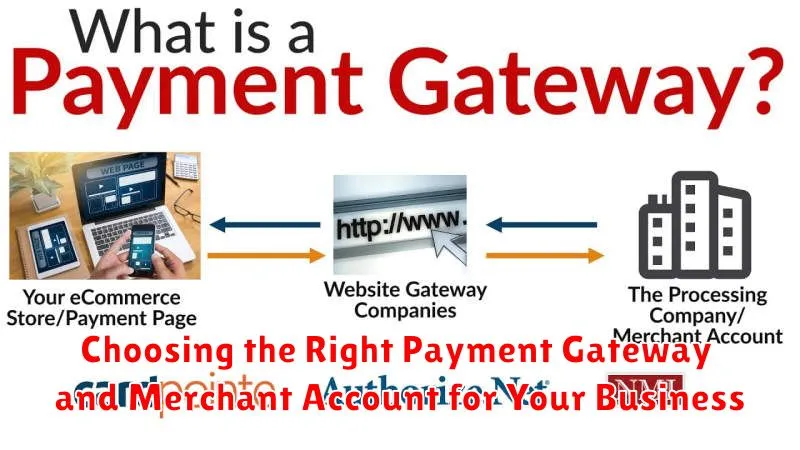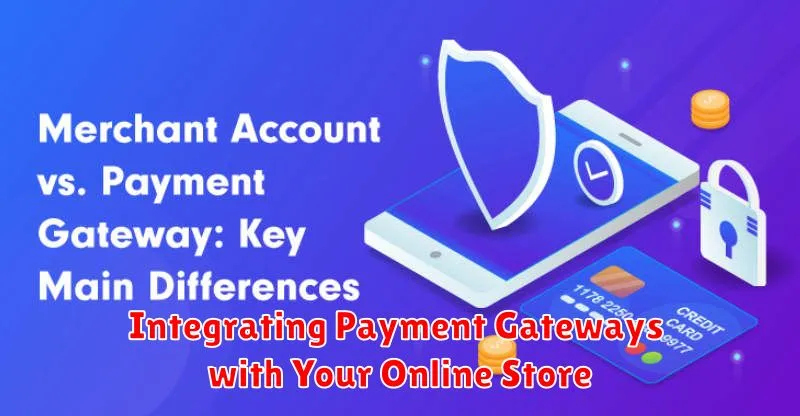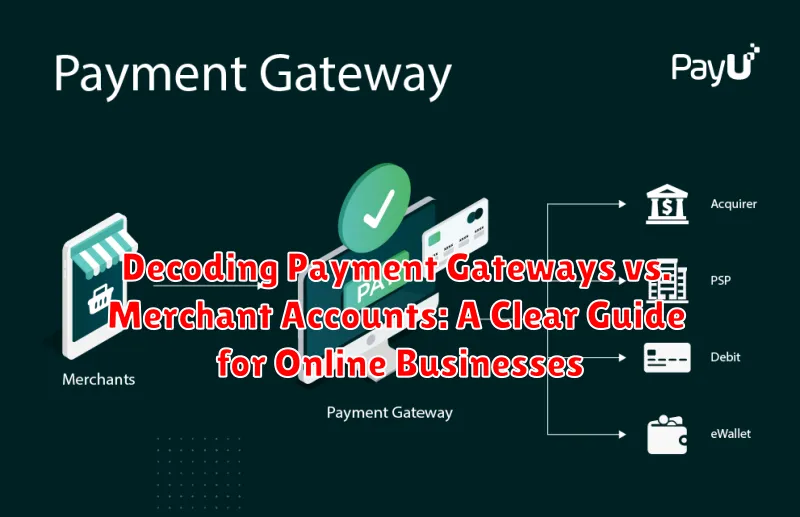Running a successful online business requires a seamless and secure payment process. Understanding the distinction between payment gateways and merchant accounts is crucial for optimizing your online transactions. This comprehensive guide will decode the complexities of payment gateways vs. merchant accounts, providing clarity for online businesses of all sizes. We’ll explore the roles, functionalities, and benefits of each, empowering you to make informed decisions about your online payment processing. Learn how these vital components work together to enable secure and efficient online payments for your customers, ultimately driving growth and revenue for your business. Whether you’re a startup or an established enterprise, understanding these fundamental elements is essential for building a robust and scalable e-commerce platform.
Navigating the world of online payment solutions can be daunting, but choosing the right payment gateway and merchant account is paramount for accepting online payments. This guide breaks down the core differences between these two essential components, explaining how they function within the broader context of online payment processing. We’ll delve into the key features and considerations for selecting the optimal solutions for your specific business needs. From transaction fees and security protocols to integration options and customer experience, we’ll cover all the critical aspects of payment gateways and merchant accounts. By understanding these fundamental building blocks of e-commerce, you can streamline your operations, enhance customer trust, and maximize your online sales potential.
Understanding the Basics of Online Payments
For online businesses, accepting payments seamlessly is crucial. The process involves a series of steps, enabling customers to purchase goods or services using various payment methods. Understanding this flow is foundational to choosing the right tools for your business.
When a customer completes an online purchase, their payment information is securely transmitted to the payment processor. This processor acts as an intermediary, communicating with both the customer’s bank (the issuing bank) and the merchant’s bank (the acquiring bank). Authorization is the key step, verifying the customer has sufficient funds. Once authorized, the funds are then captured and transferred to the merchant’s account. Finally, the settlement process completes the transaction, depositing the funds into the merchant’s bank account.
Security is paramount throughout the entire process. Sensitive data is encrypted and protected, ensuring a safe transaction for both the customer and the merchant.
What is a Payment Gateway?
A payment gateway is the digital equivalent of a point-of-sale terminal in a brick-and-mortar store. It’s a technology that securely authorizes credit card and other electronic payments for online and e-commerce transactions.
Think of it as the bridge that connects your customer’s payment information (credit card number, expiration date, etc.) to your merchant account.
The gateway encrypts sensitive payment data, ensuring it’s transmitted securely between the customer, the merchant, and the payment processor. This protects both the business and the consumer from fraud.
Essentially, a payment gateway facilitates the transfer of funds from the customer’s bank to the merchant’s bank account.
How Payment Gateways Work
A payment gateway acts as a bridge, securely connecting your online store with the payment processor and the customer’s bank. Think of it as the digital equivalent of a point-of-sale terminal in a physical store.
When a customer completes a purchase, the payment gateway steps in to securely transmit the transaction details. This process involves several crucial stages:
-
Authorization: The gateway sends the transaction information to the customer’s credit card network (e.g., Visa, Mastercard) for authorization.
-
Authentication: Security measures, such as 3D Secure, may be employed to verify the customer’s identity.
-
Capture: Once authorized, the gateway captures the funds from the customer’s account.
-
Settlement: The gateway facilitates the transfer of funds from the customer’s bank to your merchant account.
By handling these steps securely and efficiently, payment gateways ensure smooth and reliable online transactions for both businesses and their customers.
What is a Merchant Account?
A merchant account is a special type of bank account that allows businesses to accept payments via credit and debit cards. Think of it as a holding area for customer funds before they are transferred to your business’s regular bank account. It’s essentially an agreement between your business, a merchant acquiring bank (also known as an acquirer), and a payment processor.
When a customer makes a purchase using their card, the funds are first deposited into your merchant account. The acquiring bank then settles these funds, minus processing fees, into your business bank account typically within a few business days. Having a merchant account provides a secure and regulated environment for processing card payments. It also offers protection against fraud and chargebacks.
Why You Need Both a Payment Gateway and a Merchant Account
While seemingly similar, payment gateways and merchant accounts serve distinct yet interconnected roles in online transactions. They work together to provide a secure and efficient system for processing payments.
Think of it like this: the payment gateway is the bridge that connects your online store to the payment processors (Visa, Mastercard, etc.). It securely authorizes the transaction. The merchant account, on the other hand, is the destination where the funds are deposited after a successful transaction. It’s essentially a specialized bank account for your business to receive online payments.
Without a payment gateway, you have no way to securely transmit transaction data. Without a merchant account, you have nowhere for the funds to be deposited. Both are essential components of a functioning online payment system.
Choosing the Right Payment Gateway and Merchant Account for Your Business

Selecting the right payment gateway and merchant account is crucial for the success of your online business. Several factors influence this decision, ensuring smooth transactions and optimal financial management.
Transaction Volume: Consider your anticipated sales volume. High-volume businesses benefit from gateways offering lower per-transaction fees. Conversely, low-volume businesses might find gateways with higher per-transaction fees but lower monthly fees more cost-effective.
Business Type: Your business type impacts your needs. E-commerce platforms might require specific integrations, while subscription-based services need recurring billing functionality.
Security: Prioritize security features. Look for gateways compliant with PCI DSS (Payment Card Industry Data Security Standard) and offering fraud prevention tools.
Customer Support: Reliable customer support is essential. Choose a provider with responsive and helpful support channels for troubleshooting and assistance.
Pricing Structure: Carefully evaluate the fee structure. Understand transaction fees, monthly fees, setup fees, and any other associated costs. Compare different providers to find the most suitable option for your budget.
Benefits of Using a Payment Gateway and Merchant Account
Leveraging both a payment gateway and a merchant account offers significant advantages for online businesses. This combination streamlines transactions and enhances the customer experience, leading to increased sales and improved operational efficiency.
Improved Security: Payment gateways encrypt sensitive customer data, reducing the risk of fraud and data breaches. This builds trust and protects both the business and its customers.
Faster Processing: Payment gateways automate the transaction process, leading to quicker payment confirmations and reduced processing times. This efficiency improves cash flow and allows businesses to manage funds effectively.
Expanded Payment Options: Accepting a wider variety of payment methods, including credit cards, debit cards, and digital wallets, caters to a broader customer base. This flexibility enhances customer convenience and can lead to higher conversion rates.
Seamless Integration: Modern payment gateways integrate seamlessly with popular e-commerce platforms and shopping carts, simplifying the setup process and reducing technical complexities for businesses.
Detailed Reporting: Gain valuable insights into sales data, transaction history, and customer behavior through comprehensive reporting features. This data empowers businesses to make informed decisions and optimize their sales strategies.
Common Misconceptions about Payment Gateways and Merchant Accounts
Several misconceptions surround payment gateways and merchant accounts, often leading to confusion for businesses. Let’s clarify some common misunderstandings:
Misconception 1: They are the same thing.
A payment gateway is the online equivalent of a point-of-sale terminal. It securely authorizes and transmits transaction data. A merchant account, on the other hand, is a bank account specifically for receiving customer payments. They are distinct but work together.
Misconception 2: A payment gateway is all you need.
While some providers offer combined services, a payment gateway alone cannot process funds. You still need a merchant account to receive the money from customer transactions.
Misconception 3: All payment gateways are created equal.
Payment gateways vary significantly in terms of fees, features, and supported payment methods. Choosing the right one depends on your specific business needs and target audience.
Misconception 4: Setting up is complicated and time-consuming.
While the application process requires some documentation, modern providers often streamline the setup, making integration relatively quick and easy.
Integrating Payment Gateways with Your Online Store

Integrating a payment gateway into your online store is crucial for accepting online payments. The integration process typically involves working with your chosen platform and the payment gateway provider.
Most popular e-commerce platforms offer pre-built integrations with various payment gateways. This simplifies the process, often requiring you to simply select your preferred gateway and enter your account credentials. For platforms without a direct integration, you’ll likely need to use the gateway’s API or work with a developer to implement the connection.
Key considerations during integration include:
- Compatibility: Ensure your chosen platform and gateway are compatible.
- Security: Verify the gateway’s security measures and compliance with PCI DSS standards.
- Testing: Thoroughly test the integration in a sandbox environment before going live to ensure all transactions process correctly.
Once integrated, customers can seamlessly make purchases on your website, with the payment gateway securely processing their transactions.

